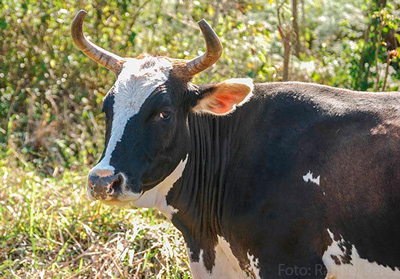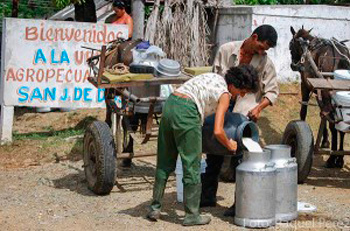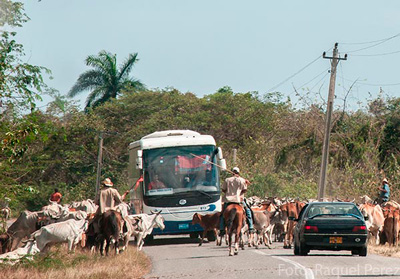Cuba’s Prodigious Cow and its Hungry Sisters
 HAVANA TIMES — I’ve just had the pleasure of watching Cuban filmmaker Enrique Colina’s documentary on Ubre Blanca (“White Udder”), the Cuban record-breaking cow that produced over 110 liters of milk in a single day – an animal so prodigious it managed to eclipse the United States’ best milk producer.
HAVANA TIMES — I’ve just had the pleasure of watching Cuban filmmaker Enrique Colina’s documentary on Ubre Blanca (“White Udder”), the Cuban record-breaking cow that produced over 110 liters of milk in a single day – an animal so prodigious it managed to eclipse the United States’ best milk producer.
Given the political and ideological implications of this feat, Ubre Blanca (1972-1985) was given protection against potential acts of sabotage through rigorous security measures. A control post was set up at the entrance to the dairy farm and only authorized personnel, whose names were kept on a list, were allowed to enter the premises.
That said, the prodigious cow was paid a visit by nearly all foreign politicians who travelled to Cuba. In fact, 26 foreign journalists were invited to document the milking process and report on the achievements of Cuba’s livestock industry to the world.
The affection Cuban that farmers felt towards the cow was such that, on occasion, they would feed her oranges. The Cuban press, for its part, insisted that the cow’s massive milk yield was merely the tip of the iceberg in a country that was producing 1 million liters of milk every day.
The whole affair reached such proportions that the dairy farmers had the obligation of reporting on Ubre Blanca’s milk production to the country’s top leadership on a daily basis. And it was said at the time that, in less than a year, Cuba would become one of the countries that exported beef to Europe.
Cuba’s Dying Livestock Industry
Shortly after watching the film, I opened up Granma, the periodical of Cuba’s Communist Party, and one of its articles returned me to reality in one fell swoop. There, I read that, in the province of Villa Clara, more than 18,000 heads of cattle died of hunger and thirst and an additional 5,000 were stolen last year alone.

Most of these cows and calves died because “a strategy capable of guaranteeing that bovine cattle is fed during droughts is lacking.” My colleagues at Granma add that, in addition, there’s an indeterminate number of “missing” bulls – animals that simply disappeared.
It is said that killing a cow illegally in Cuba can land a person in jail for 20 years. If this is true, high agriculture officials, whose failure to plan caused the death of so many animals last year, would have to be confined for 400 thousand years.
Instead of handing themselves over to justice, however, they steer the shot away from them and towards farmers, insinuating these use cow feed to fatten pigs and breed poultry (though they acknowledge such an accusation is something “few have been able to demonstrate.”)
What has been demonstrated by a study conducted by experts from Villa Clara’s Provincial Agriculture Bureau is that “the lack of water, sugar cane and king grass constitutes the chief cause of 60% of cattle deaths in the region.”
This is by no means a new development. In 2011, farmers failed to deliver “30 million liters of milk, an incident that forced to the State to apportion an additional 14 million dollars to import the powder milk the country needs,” the most official of Cuban newspapers reports.

If the same schemes and methods are repeated and the same managers are entrusted to rectify this economic disaster, then it is very likely we will end up where we started or an even worse place (in Villa Clara, 1,140 more cows than in 2012 died in 2013).
Cuba’s agricultural sector is bellowing – and mooing – for a new production scheme, one with different distribution mechanisms, adequate prices, timely payments, sufficient stock and an administrative policy that allows famers to rapidly overcome obstacles.
Such combination of measures entails, in addition to changing “everything” that must be changed, replacing “everyone” who needs to be replaced. This would demonstrate that the revolution’s commitment is with the people alone, as the Cuban president proclaimed in January.
The difficulties involved in breeding cattle in a tropical country with scarce water and grass resources are immense, but letting cattle die of hunger and thirst is unforgivable, given the nutritional needs average Cubans have and the money the country invests on imports.
A dairy farmer told me that putting together a healthy herd of cattle can take years, but that destroying it can take a few days. We could also say that developing a good livestock industry requires the hard work of thousands of farmers, but that, to ruin it, a handful of inept officials suffice.
—–
(*) An HT translation of the original published in Spanish by BBC Mundo.






It sounds like this was written directly by the CIA. Cowshit.
Irrational laws and not a lack of grass is what killed the dairy industry in Cuba.
Growing up in Cuba during the 80’s I remember all the propaganda related to Ubre Blanca. I also remember how many people could not get a glass of milk on a daily basis. Looking back, I am not surprised at all. As others have pointed out the Cuban government is very inefficient. It’s hard for them to be efficient when they are not impacted by the lack of milk or some of the irrational laws that they put in place.
If you look a little bit deeper you will see that the failure of the dairy industry in Cuba has a single root cause, the inefficiency of the country’s government. To have milk and all other products that depend on the cows (milk, butter, cheese,
leather, manure to be used as fertiliser, etc) you need cows.
The Cuban government created laws that prevented (and still prevent) farmers from being able to produce and freely decide what to do with their production. For instance, if you are a farmer and you have a ranch and are able to produce 5000 litres of milk on a daily basis, you won’t be able to sell this milk to the people in your town or to bring it to another city or make a contract with a businessman that will buy the milk from you at a reasonable price and sell it somewhere else. Instead, your only choice according to the government laws is to sell the milk to the government at a ridiculous low price that does not cover your expenses and does not provide any incentive for the farmers. Farmers are not allowed to kill their own cows if they want to have meat for their families, etc. If you own a cow and it’s stolen and killed you will receive a large fine (the government assumes that you were involved),etc.
The end result of these laws is a complete lack of interest on the part of the farmers to put the effort to grow cattle. If you were a farmer in Cuba and you did not see a reason to have a large herd of cattle, you will try to keep only as many cows as needed to satisfy only the needs for milk for your family and for this you normally need a couple of cows. This in turn will cause the number of cows in the whole country to decrease and if for whatever reason any of these leftover cows dies that farmer probably will not put the effort in replacing it.
As a consequence of these laws I witnessed farmers that falsified vet documents to certify that their cows were sick and “legally” put them down to be able to eat meat from their own cows. Another technique was to put the cow in the train tracks. Of course, normal sickness and illegal killing also took a toll on the remaining cows.
Of course the main reason, according to the government, is the blockade and this is their explanation for the lack of everything. That is why the main supporter of the US embargo is the Cuban government a not the politicians in Capitol Hill.
A while back I came across an article in the Economist that had to do with Cuban Agriculture. It stated that in 1959 Cuba had twice as much cattle. How can that be? Like Moses says they only need grass! Was Cuba a more fertile place 55 years ago?
The inefficiencies and absurdities of central planning account for the administrative part of the problem, but there’s more to it than that. The rigid totalitarian political structure inflicts injustices, crimes against human rights and abuse if power which all harm. The dogmatic ideology produces insane initiatives and punishes rational problem solving.
The recent economic reforms purport to decentralize some, but not all, of the administration of farms. But the political power structure remains intact and the Marxist-Leninist ideology continues in force, stifling any original thought.
And so the cattle starve, the herd shrinks and the regime officials get rich by controlling the importation of food.
Ubre Blanca is not the story of a failed cattle industry, it is the story of journalists paid and controlled by the communist party to make an entire generation believe that abundance was coming, that abundance was certain in a superior future that was only reserved for the communist society.
“el ojo del amo engorda al caballo”
….the wonders of central planning
As you travel south on I-5 through the California central valley town of Patterson and look to the left, you see cattle from the interstate all the way east to the horizon. There are tens of thousands of cows, mostly dairy in this part of the state.
I simply can not understand why the Castros can not raise cattle. They eat
grass! The regime’s incompetence and inability to feed itself has nothing to do
with the US embargo and everything to do with poor planning and management.